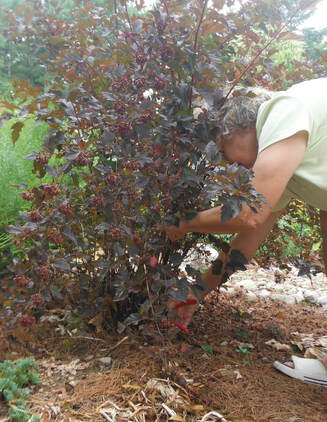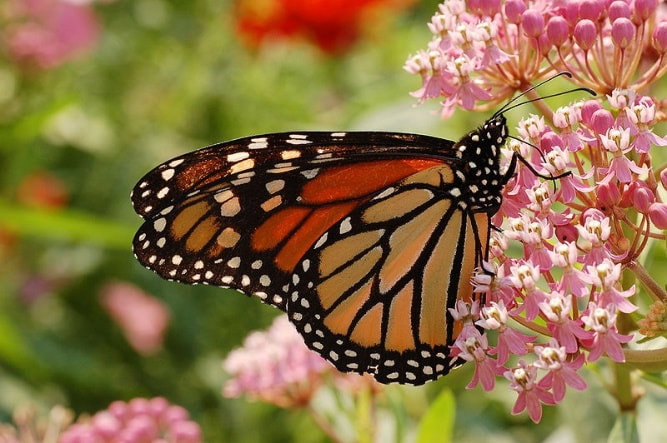Horticultural Hints for September!
|
Click on their website for an encyclopedic collection of information on native plants, and well worth bookmarking. You can see Doug Tallamy on restoring native landscapes at home, or William Cullina discussing "Sugar, Sex and Poison". There are 13 videos available to view, each one roughly an hour in length. They’re informative, frequently humorous, and memorable. Try them out! |
|
Leave the leaves where they fall!
Mow them into the lawn to add nutrients. And stop bagging grass clippings! They will completely disappear in a couple of days unless you missed several weeks’ mowings. Not only do you save work, you are returning necessary nutrients to the soil. Above: A hard trim of this physocarpus (ninebark) will result in a more compact plant next year. Shrubs can be cut to their base and re-grow the following season to a more manageable size.
Renew a shrub. Do you have a foundation shrub that is too tall, too wide, or shaggy? You can give it a makeover by pruning this fall. Removing a few of the branches will encourage the growth of new stems from the roots. Late this month, prune up to one-third of the oldest, thickest stems, down to ground level or just slightly above. In the spring, young healthy branches will quickly fill in the spaces you created. If it’s a blooming shrub, you may have to wait another year in order to get flowers on those branches. But rejuvenating the shrub is the best way to keep it blooming and attractive as the years go by. Do you appreciate Monarchs? Fall is time to collect milkweed seeds for next spring. Use only seed native to your area and pick only dry brown pods. Pods must be dry to ensure seeds are mature. Plant the milkweed in the fall in a sunny location by sprinkling seeds over loosened soil. Pat them down, add a thin layer of top dressing and water well. In the spring the plants should appear. Monarch caterpillars will be along to munch on the leaves several times through the summer. A variety of flowers throughout the summer will keep the monarch butterflies nearby.
|
It's a great time to start composting.
Buy (or build) a closed compost bin that give you a discreet place to recycle. Start with a layer of leaf mold (old leaves that are breaking down without any help from you) or compost from a friend. The bacteria and fungi that do the composting will be in there. Grass clippings (with or without leaves) can be added to your vegetable and fruit peelings, leftovers, or plants too far past their prime. Repeat throughout the fall and spring. Next year, you’ll have the compost needed to give a boost to your new plantings and old beds! Add to your garden soil’s fertility. Create a nutrient-rich base layer by collecting grass clippings and raked leaves to spread over the bed, as long as you didn’t use “weed and feed’ or other broad-leaf weed killers (flowers and vegetables are broad leafed). With vegetable gardens, usually we take away the plants that were growing there this year to reduce the possibility of diseases or insects from wintering over. But any vegetable plant not affected by disease or insects can be chopped, and left behind. The leaves from corn plants, the overgrown lettuce heads, the tops of carrots and so forth are a starting point. But don’t forget all those leaves that fell on yours or your neighbors’ lawns. Pick them up with your mower bag and they’ll be shredded and ready to improve your vegetable garden.
|
Look for water that can be reused.
Do you have a rain barrel? Capturing the water that runs off your roof is a smart solution to water bans. A quarter to a half inch of rain will fill the barrels connected to gutters on a home roof. With a watering ban in many towns this year, after cooking eggs or vegetables, the water shouldn’t go down the drain. Some nutrients from these cooked foods will leach into the water and, once cooled, can be used to water (and feed) plants. Don’t forget cover crops.
Cover crops become “green manures” when a gardener turns them into the soil in the spring to provide organic matter and nutrients. Green manures include legumes such as vetch, clover, beans and peas; grasses such as annual ryegrass, oats, raprseed, winter wheat and winter rye; and buckwheat. For your home garden chose those that will grow in the fall and not need to be tilled under in the spring. You want to let Mother Nature do most of the work. Be wary of animal manure, though. Remember that not all weed seeds get digested, some manure can be too rich in one element, and that manure can carry dangerous pathogens. And it’s not fun to spread on the garden. Don’t rake those leaves! Take a look at the forest floor: it is covered with leaves. They provide the only nutrients the native trees get. They are the mulch that protects the roots and new seedlings. Traditionally, we rake leaves out from under trees and shrubs because it ‘looks neater’ and we think those leaves will form a mat. Instead, leave them in place. Some will break down over the winter, returning the nutrients to the soil in the process. Those that remain will help protect the roots and crowns of your plants as well as provide an over-wintering home for beneficial insects. Cleaning them out is a spring chore.
|












